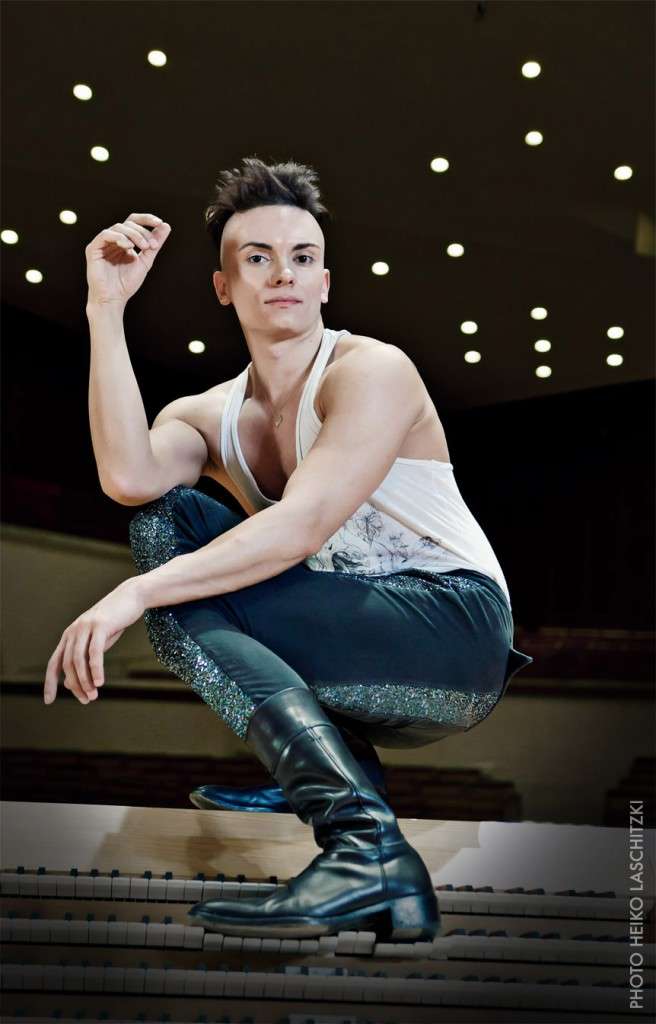|
Back
Dazzle plus depth Toronto
Koerner Hall
04/07/2013 -
Aaron Copland: Music for the Theatre
Cameron Carpenter: The Scandal
J. S. Bach: Cello Suite #1: Prelude (Elaboration by C. Carpenter) –
Das wohltemperierte Klavier: No. 15 – Great Fantasia and Fugue in G minor, BWV 542
Franz Liszt: La Campanella
Cameron Carpenter (Organ)
The Kitchener-Waterloo Symphony Orchestra, Edwin Outwater (Conductor) 
C. Carpenter (© Heiko Laschitzki)
Cameron Carpenter is that rare thing, a celebrity organist with more than just a hint of notoriety about him.
Prior to this Koerner Hall appearance, Carpenter performed two concerts with the Kitchener-Waterloo Symphony Orchestra in Kitchener in a program without the solo works in the second part. The opening work, Aaron Copland’s Music for the Theatre, was chosen as a curtain-riser to Carpenter’s The Scandal because its jazzy sound aroused a degree of scandal when first performed by the Boston Symphony Orchestra in 1925. At the time Boston was considered the height (or depth) of stuffiness, but its orchestra was headed by the venturesome Serge Koussevitzky who commissioned the piece (which, by the way, is not intended for any specific theatrical presentation). It has five movements: Prologue, with a brassy fanfare; Dance, with very eccentric rhythms; Interlude, which has more than a hint of Copland’s future pastoral sound; Burlesque, much like music for a Chuck Jones cartoon, or for the strippers in Jule Styne’s Gypsy; Epilogue, with a nice viola solo for when even jazz babies need some sleep. This engaging work was beautifully performed in a manner both thoughtful and joyous.
Which leads us to The Scandal, a tone poem with a program that was premiered in 2011 in Cologne by the German Chamber Philharmonic Orchestra. According to the composer’s notes, the organ represents the protagonist of a scandal and the orchestra, public reaction. It starts off in such a big, noisy way (referee’s whistle among the sounds produced) that it doesn’t seem capable of developing further. There is a quiet interlude featuring nice use of wind instruments, then later a dialogue between the organ and solo cellist, the latter part reminiscent of Strauss’s Don Quixote. This morphs into a brief concerto for organ, cello and orchestra, before the organ cadenza that is supposed to represent the guilty one’s plea for repentance (think Jimmy Swaggart).
Note that this work is Carpenter’s Opus 3 and, in his own words, “the first orchestral score I’ll admit to”. It’s hard to judge its success on one hearing, but it contains enough surprises of various sorts that keeps one’s interest. I’ve certainly heard less successful works that were prestigious major commissions.
The second part of the concert opened with the Bach works listed above played with a style I can only term as familiar abandon. They were followed by Carpenter’s arrangement of Liszt’s La Campanella which caused a delighted furore. Thus we got a frustratingly quick sampling of what he can do - very “clean”, well-defined playing - which served to whet ones appetite for a more substantial solo engagement. (Just for the record he used a Rodgers digital organ which pretty well emulates the sound of an installed pipe organ which Koerner Hall does not have.)
The organ is in dubious repute nowadays. An instrument costs a lot to install, and then is used mostly for free concerts attended only by devotees - while those who stay away think of it as stuffy and ponderous. I recently toured one of Canada’s largest music schools; it has a custom-built organ studio, but currently not a single student studying the instrument. Could Cameron Carpenter help reverse this trend? It’s hard to say. Thanks to his flashy personal style Mr. Carpenter could be mistaken for a latter-day Liberace (who famously “cried all the way to the bank” when his piano playing was found lacking). This could be why this concert was far from sold out (those who attended, however, lapped it up and begged for more.) I was on the lookout for shallow charlatanism but found real musical integrity in what he performed even if it seems tricksy to perform, for example, the opening movement of Bach’s Cello Suite No. 1 entirely with the feet, or the featherweight Chopin “Minute” Waltz (the single encore) on an instrument capable of demolishing the hall if played a full throttle. He might turn out to be a one-off - but an enduring one - much like Dame Evelyn Glennie. Anyone emulating his glittery personal style would be tagged as a wannabe.
The organ showman of the past was Virgil Fox (1912-1980) who had his performances accompanied with a psychedelic light show and encouraged audiences to chant B-A-C-H. Carpenter did not do this. Two cameras, one overhead and one at floor level, capture his movements which are projected on to a large screen. I find this to be not just a flashy gimmick but a welcome change from so many organ recitals where the player is barely visible if visible at all.
Carpenter mentioned that in 2014 he will be unveiling a new made-to-order touring instrument. I’m sure his whirlwind career will bring him back to Toronto in the near future when we can perhaps get a better overview of just what he can do.
Michael Johnson
|